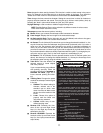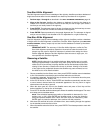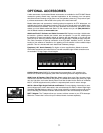
31
6.
With about 20 seconds left on the countdown timer, start watching through the eyepiece for the
satellite to enter the field of view.
7. When the satellite enters the field of view, press ENTER.The telescope starts to track with the satel-
lite
. instrument.
LPI (
Fig. 22) and Deep Sky Imager (Fig. 23) combine the power of an electronic
astronomical imager with the simplicity of a web cam. Check out the following imager features:
• LPI: Achieve great results the first time out on the Moon, planets, brighter deep-sky objects and ter-
restrial targets.
• Deep Sky Imager: Capture dim and faint objects that are often invisible to the eye, that once could only
be captured by large observatories or expensive CCD equipment. For example, the Horsehead and
Reflection nebulas in Orion.
• Easy to use with real-time display of object on your PC screen. Just center, focus and shoot.
• Magic Eye software-assisted focusing.
• Automatic and manual exposure control from .001 to 15 seconds (up to 450x longer than web cams).
• Automatically takes multiple exposures.
The AutoStar Suite Software includes powerful tools to help you get the most from your Meade ETX
telescope:
• Sophisticated planetarium program with over 19 million objects.
• Select objects from the planetarium display and the telescope slews to those objects.
• Create time-lapse movies of objects, such as Jupiter
• Create your own Guided Tours.
• Advanced Image Processing Software including Unsharp Masking, Convolution Filtering and many
other features.
• Control all AutoStar functions from your PC.
• Talking Telescope software translates AutoStar text to synthesized speech through PC speaker.
• Includes a cable to connect your ETX model to your PC.
Fig. 23: The Deep Sky Imager.
Fig. 22: The Lunar Planetary Imager.
Fig. 24: Saturn, taken with the LPI. Photo by Dave
Street.
Fig. 25: M100 galaxy. taken with the
Deep Sky Imager
.
Photo b
y Chuc
k
Domenachi.


















